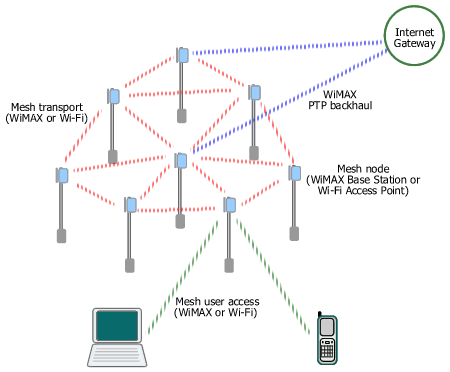WiMAX in a Wi-Fi Mesh Network
Mesh topology is not supported by existing IEEE's
wireless LAN
standards but it becomes popular as city-wide (municipal) Wi-Fi network
deployment gains more supporters day after day. In a mesh network, each node
(i.e. base station or access point) connects to several
neighboring nodes and on to a mesh gateway (i.e. a base station
that aggregates the mesh network traffic and routes it to the
Internet). Since each node has many routes to a mesh gateway, mesh network is very reliable. But
mesh network is more complex to manage and poses interference
challenge especially for operation in a license-exempt band such as
in Wi-Fi case.

Picture. Mesh Network with Wi-Fi and/or WiMAX
WiMAX can work on all layers of a municipal mesh network (hotzone/metro
zone).
By examining current Wi-Fi mesh network architecture, basically
there are three layers. These are mesh access handling user access to
a mesh node,
mesh transport interconnecting mesh nodes and routing traffic to
mesh gateways, and backhaul connecting a mesh gateway to an Internet
PoP (Point of Presence) or other content gateways.
Backhauls for
mesh Wi-Fi networks are provided using various wired and wireless
solutions, i.e. fiber optic, leased line, DSL, and proprietary point-to-point (PTP)
or point-to-multipoint (PMP) radio including some pre-WiMAX equipment. A wireless backhaul
- specifically WiMAX - enables flexible placement of a mesh gateway
node anywhere in the network, therefore it doesn't have to be
located in a telco's CO or close to a fiber/DSL termination point. The portable WiMAX
equipment (Base Station) also allows fast installation and easy
relocation. Moreover, WiMAX was designed for outstanding
performance in NLOS environment, typical in metro area with many
high rise buildings. WiMAX also can operate either on licensed or
unlicensed band, giving more options for operator/ISP/municipality
in addressing various interference conditions and users'
requirements.
The mesh transport layer provides the interconnection between mesh nodes. There is a
project in the IEEE to standardize Wi-Fi as an intra-mesh transport solution, but the
work is
still in progress. The current established Wi-Fi solution
uses proprietary technology developed by each vendor which might cause
interoperability issues in the future. WiMAX can naturally replace Wi-Fi in this layer, interconnecting mesh nodes using
standard equipment based on the IEEE 802.16-2004 or 802.16e which
includes support for optional mesh topology. Besides, WiMAX has
built-in QoS support and is
optimized for longer distance (WiMAX is a wireless MAN while Wi-Fi
is a wireless LAN) .
For mesh access layer, at present users connect using their Wi-Fi-enabled
laptops, PDAs, or
smart phones. WiMAX integration into such portable/mobile devices is
still in its early stage of development. However, in several
months/years to come
one may expect the emergence of dual-mode Wi-Fi/WiMAX devices and network adapters (NIC, PC card, PCI
Express) which can connect automatically to any
available network with the best signal.
|